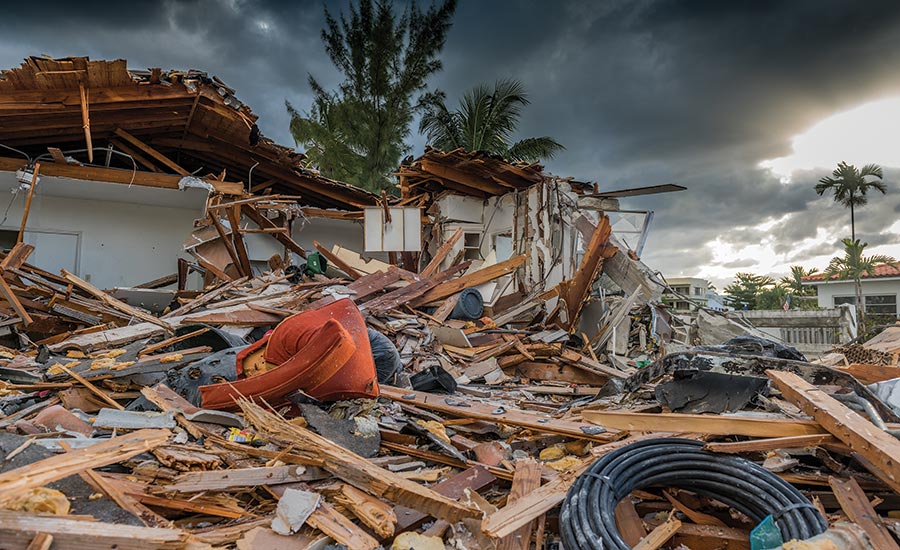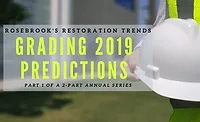Special Section
Prepping for Disaster: Restoration Trends (Part 2)
Trends and predictions for the restoration industry in 2019.

Editor’s Note:
In the March issue of R&R, Phil walked through his industry predictions from 2018 and revealed how he scored on each. His predictions included labor shortages and wage increases, industry pricing challenges, more TPA influence, growth of outside groups, and projections on weather-related events. To see how he fared, check out his March article! This month, he’s sharing his predictions for 2019!
Prediction #1: Labor Shortages.
My number one prediction for this year remains unchanged: labor shortages. Labor shortages continue to be a big issue in most restoration companies today. If unemployment goes from 4 to 4.5%, this will have little impact on your business. Looking through postings on various LinkedIn pages shows literally hundreds of open positions at various restoration companies. One company I am familiar with stated they currently have hundreds of open positions in their company alone!
I would expect some pressure to be relieved near the end of 2019, but I don’t think that will impact the pool of talent available to your company. This shortage covers all positions in restoration from frontline technicians to all management positions. In addition, it is very difficult to find skilled construction workers in most markets. The laws of economics tell me this will lead to increased cost of labor. There are some companies that are severely limited in their growth because they cannot find needed people to fill the available positions in their company.

Here are my recommendations to address this challenge in your business:
- Create a culture that draws candidates to your company. Although there are many job openings, there are many people that would make a change if they felt they could find a company with an engaging and challenging culture – one that celebrates success, creates a sense of belonging, and has a compelling vision.
- Take a look at your compensation plans and make sure you are paying at or above market wages. Define and implement an effective compensation plan that allows you to reward great performance and pay top dollar while assuring the company makes money first. Our rules to compensation are that the company must win first, must win more, and after that, the employees can win – and potentially win a lot. A competitive compensation plan coupled with a great culture will help not only attract great people but it will also help retain your top performers. The cost of turnover is very high so make sure you take care of what you have.
- Be a talent scout – always be on the lookout for great workers because they are already working. You will not likely get them to reply to an ad since they are likely not looking where you are posting your ads. Make sure the entire company knows they will be rewarded when they refer great new team members. As a leader in your company, this is a very important role. Some would argue that the top role in the company is to locate great people.
- Purchase the book “Who – Solve Your Company’s #1 Problem” by Geoff Smart and Randy Street.
- Make sure your jobs are properly prepared for subcontractors when they arrive. Realize that time is money and if they have to spend hours getting ready to work or understanding the scope, they will likely find other companies to work with. Make sure jobs and clients are properly prepped and when the work is successfully complete – make sure they are paid quickly. All of these items will not only help keep great subs, it will also help improve your margins.
Predictions #2: Weather Events Continue.
Catastrophe and large losses are one of their biggest challenges for major client groups like TPAs, property managers, and insurance companies. This will start to drive claims decisions. These groups will start to make vendor decisions based on their ability to respond to local and regional events more than everyday claims decisions.
In most areas, it is easy to solve claims needs in a normal environment. It is during peak periods where companies are feeling exposed. I expect weather events to continue to be a challenge in 2019 and the foreseeable future. This includes cold weather, spring rains, summer storms, tornado events, wildfires, and hurricanes.
I am not brave enough to predict hurricane activity this year; I will leave that up to the scientists at Colorado State University. I do expect wildfires to continue to be a challenge. The forests in the West have such a high fuel load and forest management practices have led to a dangerous environment, especially when combined with low rainfall and mountain snowpack.
I find it interesting, however, that the everyday restoration market is slow in many areas of North America, but catastrophe events are driving record insured losses. I am seeing companies outside the CAT zone struggling to maintain revenue and those inside struggling to keep up with the onslaught of work.
My recommendations:
- Make sure you have diversified marketing. Work to keep your top lead sources to less than 30% of your overall business – the lower and more diversified, the better. This will help keep the phone ringing and also help in the event that any of your work sources are slow or cut you off.
- Define a catastrophe response plan for your market. If you want to travel, plan prior to hitting the road. I recommend holding a management retreat at your office or offsite to plan for the day when you get 100’s of phone calls followed by a second or third day of the same. Break down the entire process from intake to fulfillment and collection. If you are traveling for losses, this is even more important. You need to plan for all the travel and marketing logistics as well as how you will maintain operations back home. Although it appears there is more than enough work in catastrophe zones, it is often hard to get on the paying jobsites you want.
- Know your numbers and have a responsive overhead. If you are clear on how and where you are making money and also see the signs when things are slowing, then you can create a plan for proactively managing this process. Being financially aware will help you manage peak work and proactively address the slow periods between.
- If you are always marketing, then you may find that you rarely slow down. Create a marketing and sales culture that is understood and owned by everyone. Make sure that entire staff is aware of how they can impact sales in your company and there is a plan to reward this activity.

Prediction #3: Actionable Technology.
Technology. This has been a slow-moving trend, but it is starting to become a reality for today’s restoration and insurance companies. I have been watching the insurance claims industry as they assess new technology to streamline operations and provide better, more accurate service. This year, many of these trends are becoming actionable. I know franchise groups have specialists studying the technology options, so their companies are aware of the coming trends but are you? If you are not looking at technology for your business, you will be left behind.
Here are some things you should be aware of because they are becoming a reality in the claims world and the technology is affordable and available.
- There are several companies that are using machine learning and artificial intelligence to help you provide better estimates. You can upload your estimates and they will be able to recommend scope items that you may have missed based on the other items that are present. This will be a great help in estimating accuracy for restorers and hopefully will be accepted by the insurance industry.
- Better underwriting, claim communication, and documentation are being combined into a seamless package. Companies like Encircle and Matterport lead with the technology to drive this trend. Both of these products/services help bring efficiency in estimating to your business and greater documentation and accuracy. In most companies, the estimator group is among the highest paid in the company. This technology will likely change the way that data is gathered and estimates created. I expect that in five years or less, the camera will document, measure, and scope many jobs – at least where there is little structural damage. Right now, 3D images are being used for underwriting and can be connected to the claims process to properly follow the property through the claim. Images taken during the first notice of loss will help verify damages, assist in setting reserves, and prevent fraud. I am not sure the role of the contractor in this process, but it will be helpful to utilize the same platform.
- Internet of things will be used to identify risks and potentially limit damages. Now that many people have so many smart-enabled devices in their homes and businesses, insurance companies are better able to identify risk factors and potential damages before they happen or immediately after. This technology may limit the overall damage - for example a broken waterline or water heater that shuts off the water and notifies individuals of the damage. I don’t see this impacting restorers much, but it will eventually diminish damages.
Prediction #4: Cost Inflation
This is not a new trend, however it is a continuation of issues that have been building over the past couple of years. Input costs are increasing due to labor issues throughout the supply chain as well as pricing for many construction products and services. Your pricing database is measuring this, however I have not seen a commensurate pricelist increase.
Contractors are in some ways responsible for this situation as well as they are not updating retail pricing. Every uploaded estimate is sent through pricing feedback which affirms the prices used in that estimate. It is my expectation that the construction industry will see continued price escalation throughout the year. If we experience another wildfire or strong hurricane season, then I would expect that to impact prices as well. Construction continues to be strong and the available pool of skilled trades and available employees are not growing with the demand.
Here are some possible responses to higher prices:
- Be price-aware and work to lower your acquisition costs for materials.
- Have a plan for updating your price lists and proactively reporting price increases. Take time this year to learn more about impacting the pricelists in your local market. The software programs you use have the ability to properly affect your pricing. If you need resources for this then send me an email and I will appropriately direct you in this endeavor.
- Have really good metrics that allow you to understand your costs and profitability in all areas of your business. Just thinking or feeling that your costs are increasing or profits decreasing is not enough. You need to have information to properly manage your changing business.
- Budget your projects and all major purchases. Too many companies overlook the need for managing all of your expenses. You should be in control of how you spend all of your money in your business – talking a look at your job cost sheets after the job is complete or the financial statements after the month is complete makes you an unnecessary victim. If you know your costs are changing, then take charge of where and how you are spending money.
- Look to use time and materials rates where possible. This should help you properly reflect the cost of doing business regardless of the changes in your costs.
- Take a look at your indirect costs. This includes the administrative team, your estimators, vehicles, and other items that are not often job costed. If you do not have budgets or targets for these items, they can quickly and quietly inflate.

Prediction #5: Cyber Crime.
This is not a big deal; until it is. The attacks are targeted and will not hit multiple companies at once or the industry as a whole. It is not an industry trend, but it is a reality that your business needs to have a plan to address. Being hit with a cyber-crime can destroy your business, or at least be an unnecessary distraction that will keep you from properly serving your clients and may have a substantial financial consequence.
My recommendations:
- This should go without saying, but your business needs a cyber insurance policy. This is to cover not only having your information hacked, but also in case that your client’s information is stolen through your company. There are many different types of policies, therefore make sure you have a conversation about the options and risks to your business. Cyber insurance may only cover your business if you take steps to prevent and mitigate the risk. You should be aware of your policy, and your responsibilities. You should work closely with your IT department to understand your policy and your responsibilities. I have worked with companies that have a several tier plan of ways that the company can prepare and prevent attacks, or respond in the event of an attack. There will always be more you can do, so you should have a plan and a budget for various options and then make an appropriate action plan based on your company, resources and potential risk.
- Prepare a contingency plan to determine how long you can work without your network and various options for restoring your network in the event that you are held hostage. This is a very fast-moving world and I recommend you consult with and work with specialists in this field. I am sure Marriott, Target, and Experian thought they had a good plan – until they didn’t.
Prediction #6: More Flexibility in Program Work
I am not sure if this is a prediction or just wishful thinking, but I expect to see some more flexibility for management of contractors in these programs. I am hearing developments right now that are very detrimental to contractors from previously strong insurance companies. In the current work environment (labor shortages, increasing costs, increasing customer expectations, and a strong economy), I think contractors have some leverage. The TPA’s are not able to fill the demand for services in some key markets. Many of their best contractors are reducing zip code coverage. Right now, the claims examiners and adjusters are aggressively managing the claim and the contractor; I am hopeful this will change. Perhaps a TPA will emerge that is friendlier to the contractors. This is not evident at the beginning of the year, but maybe it will start to change in third or fourth quarter of this year. Consider this a bonus prediction – because my confidence is low.

Recommendations:
- Make sure you limit your work from any one client to less than 20%. This way you are in control of your business and not beholden to the demands of any client.
- Do what is right. You are the restoration professional. Make sure you work to preserve the property and protect the occupants of any damaged property.
- Look for ways to streamline and reduce the cost for repetitive items in your company. You may have estimators and project managers that focus on the relatively simple program jobs – estimating, reporting, job management.
- It is OK to be a “program” contractor. There are a lot of great companies doing good work and making money while working as a part of programs. Just make sure you have balance. Some things that I have seen from companies doing this type of work:
- Lower margins.
- Smaller average job size.
- Being asked to do less than is required to restore the property.
- Having increased overhead due to the additional administrative responsibilities.
- Being overly dependent on a single work source that disappears overnight.
- “Take it or leave it” settlements.
An Age of Change
The restoration industry is in a real time of change. There are many influences and things both within and outside of our industry that are both within our control and outside of it. It is more important than ever that you are in control of your business and your strategy. The decisions you make today will allow you to be a victim or a great success. Now it is more important than ever to be a leader in your business and your industry.
Looking for a reprint of this article?
From high-res PDFs to custom plaques, order your copy today!






